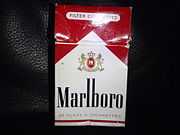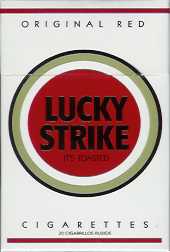China Tobacco
 | |
| Type | Government-owned corporation |
|---|---|
| Industry | Tobacco |
| Founded | January 1982 |
| Headquarters | Beijing, China |
| Area served | China |
| Key people | Jiang Chengkang (President) |
| Products | Cigarettes |
| Owner(s) | State Tobacco Monopoly Administration |
| Website | www.tobacco.gov.cn |
China National Tobacco Corporation, trading as China Tobacco, (Chinese: 中国国家烟草公司) is a Chinese state-owned manufacturer of tobacco products. It enjoys a virtual monopoly in China, which accounts for roughly 30% of the world’s total consumption of cigarettes, and is the world's largest manufacturer of tobacco products measured by revenues.
Background
China National Tobacco Corporation was founded in 1982 and falls under the jurisdiction of the State Tobacco Monopoly Administration or STMA (also started in 1982); this organization is responsible for enforcing the tobacco monopoly in China. While the STMA manages the monopoly, China Tobacco caters to its customer base of 350 million smokers, who consume 1.7 trillion cigarettes every year.[1] The China National Tobacco Co. is responsible, under the close supervision of the STMA, for marketing, production, distribution, and sales of all tobacco products in China. Organization trickles down; China Tobacco contracts out orders to smaller, local factories. In turn these factories fill orders and deliver them for distribution to China Tobacco’s distribution chain. The smaller local factories pay a sort of tax to China Tobacco, but keep much of their profit. In turn, retail distributors buy cigarettes from China National, and the profits China National realizes from those sales is in turn taxed by the STMA.
History
A major objective of China Tobacco and the STMA has been modernization. As recently as the 1980s, China's independent tobacco factories used outdated equipment to the extent that some processes were even carried out by hand. To accomplish their goal of modernization, the STMA allowed a small number of foreign companies into the country, in exchange for modern equipment. Though deals generally favoured China, it allowed foreign companies to gain hard-to-come-by connections within China, and at high levels within the tobacco monopoly itself. The acceptance of foreign competition sparked a massive demand for tobacco production equipment in the 1990s, which has since slowed. However, major factories in China now count their production of cigarettes in tens of thousands per hour.
At the same time, China Tobacco has consolidated its factory base; currently there are 130 cigarette factories in China, compared with a 1997 number of 180. To further their goal of consolidation China Tobacco plans to reduce the number of factories below 100 in the near future. This has led to increased efficiency within the industry, allowing for greater production and brand variety than were possible before. In fact, many brands made by only one or two small regional factories have been licensed to large factories, becoming nationwide successes.
Brands
China Tobacco, like many other tobacco companies, produces a plethora of brands – over 900, the largest of which, Hongtashan (Red Pagoda Hill), accounts for only 4% of total sales. Though, unlike with manufacturers outside of China, the vast majority of cigarettes sold in China are of very low quality. Up to 75% of China's population still resides in rural farming regions, and they simply cannot afford high or even mid-priced cigarettes. Therefore, Class D quality cigarettes enjoy the highest production rates in China, while Class C quality cigarettes bring in the largest gross profit. However, high-quality national brands do exist in China, though they are very hard to find outside of major cities and reputable retailers.
Trends in cigarette buying have not been lost of China either. In recent years several varieties of cigarettes targeted at women have been released (breaking a longstanding taboo). Varieties common internationally are just as common in China: Unfiltered, Filters, Lights, Ultra Lights, 100's, and 120's are all available in a variety of brands.
Foreign brands are to this day not unknown in China, since their introduction with the advent on China Tobacco and the STMA. Marlboro, 234, Camel, Kool, Lucky Strike, 555, and a variety of other brands can all be found in large cities in China. However, while these cigarette brands are marketed as premium brands outside of China, within China these cigarettes are made locally under license from local tobacco, and their quality usually falls to a mid-range (with certain exceptions for cigarettes still made solely outside of China, like Lucky Strikes and Marlboro). Foreign sales make up only 3% of the Chinese market, yet this still accounts for 51 billion cigarettes every year.
|
Problems
China Tobacco faces a number of serious problems: namely, the counterfeiting of premium and foreign cigarettes, as well as a growing public awareness of the health risks inherent in smoking. The counterfeiting problem has grown to the extent that many customers, who would otherwise buy premium cigarettes, now purchase mid-range products to avoid "junk" counterfeits so pervasive in premium brands.
Advertising in print, radio, and television has been banned in China, and even outdoor ads require prior approval provided they are not in one of nearly 100 local jurisdictions where outdoor tobacco ads are banned. These restrictions have forced China National into a strategy that harkens back to the 60's and 70's in the United States; with "cigarette girls", attractive women dressed in brand logos, handing out samples, lighters, and promotional material in front of clubs and bars. Another form of circumvention is printing outdoor advertisements in the name of another entity, the latter's name being clearly printed on the material. For example, the Hongtashan brand mentioned above has recently published their new climbing-themed advertisements through a Hongtashan Climbing Club.
China Tobacco can also look forward to an anti-smoking lobby that is currently small but growing. In recent years, legislation from politicians have increased, banning smoking in many enclosed public areas. The press in China has not been silent either; numerous editorials criticizing smoking on everything from health to pollution have become more and more common place.
China Tobacco and more specifically the STMA also deal with constant attack from the World Trade Organization to loosen their monopoly. Rather than loosen it however the STMA has taken steps, in the name of anti-counterfeiting, to strengthen the monopoly. However, since 2001 increasing access has been granted to foreign companies. Yet this access is still fairly limited and does not show signs of further liberalization in the near future.
See also
- Smoking in the People's Republic of China
- World Health Organization Framework Convention on Tobacco Control
- List of companies of the People's Republic of China
References
External links
- Official website
- An overview of the STMA and the Chinese cigarette industry (by Chuck Bennett)
- U.S. Report on Tobacco Production China (Anne Todd, USDA Rural Development)






